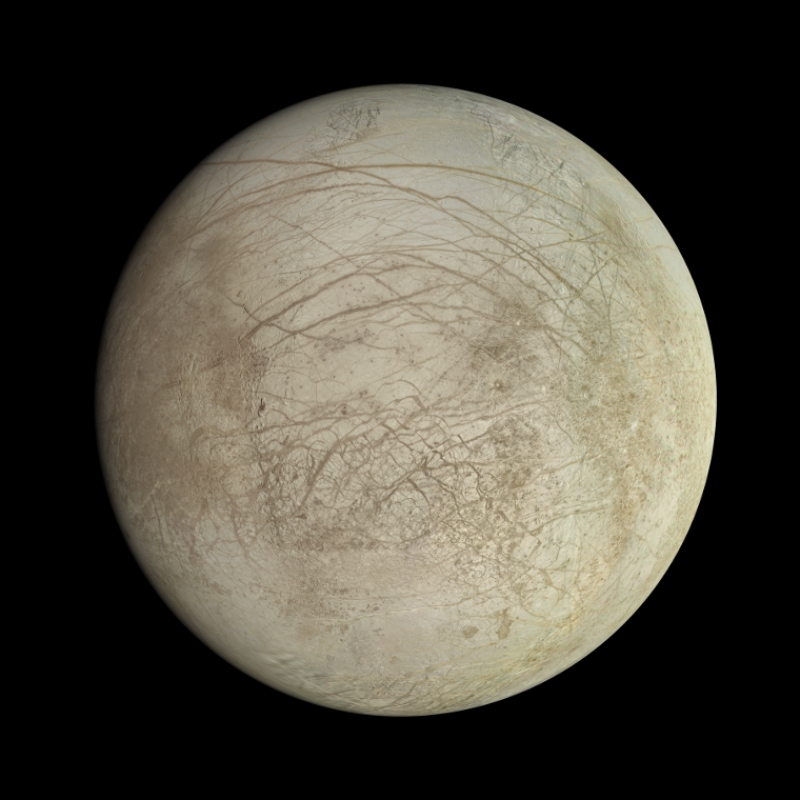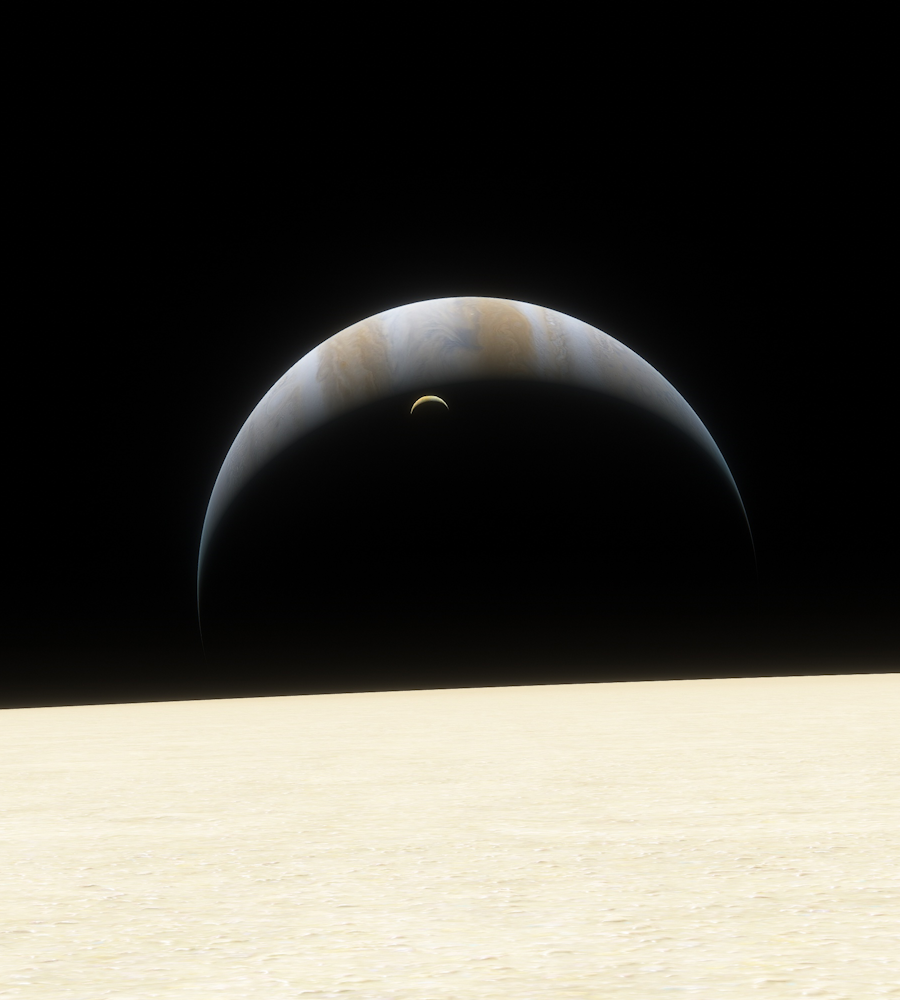Europa
Europa is the second and smallest major moon of Jupiter; a small telluric world blanketed in a thick layer of ice and liquid water. Its subsurface ocean, heated by the intense tides exerted by Jupiter, plays host to the only natural panspermic branch of terragenid life: the Europaelia polyphyletic group. Though the entire moon is considered a nature preserve, it does support a modest population of 120 million people under the flag of the Jovian Federal State of Europa.
Geography
Location
Europa is the second major moon of Jupiter, orbiting just on the edge of the outer radiation belt. It is in a 1:2:4 orbital resonance with Io and Ganymede, adding significantly to the already potent tidal heating presented by Jupiter itself. Its orbit lies within the outer regions of Jupiter's notoriously potent radiation belts, with an average of 225 milli-Sieverts per hour —more than enough to kill most sophonts with 20+ hours of sustained exposure. Thanks to radiation shielding technology, however, the Jovian orbital sphere is quite well-developed; the orbit and orbital band of Europa is full of satellites and stations serving various functions like communication, power distribution, and orbital refueling.Surface
Europa's surface is a glacial blanket about five kilometers thick on average, made primarily of water ice mixed with various mineral salts and organic compounds. Despite its many scarps and crevasses, the surface of Europa is one of the smoothest of any body in the system, owing largely to its overall youth. The oldest sampled areas of the Europan ice crust date to roughly 120 million years ago, with much of the surface being significantly younger. This is because the ice crust functions almost exactly like the rock crust of Earth and other terran worlds: it is a tectonic surface. Vast slabs of granite-hard ice are constantly rising, diverging, colliding, and subducting once again into the liquid water "mantle" that accounts for roughly 90 kilometers of the moon's 1560 km radius.Subsurface
The Europan ocean, while super-oxygenated thanks to a quirk of surface chemistry, is a cold and lightless abyss nearly an order of magnitude deeper than the deepest point in the oceans of Earth. The majority of it is empty, open water, occasionally shot through with roiling vertical warm currents rising from geothermal vents on the seafloor. Indeed, the edges of the internal sea —both upper and lower— are the interesting parts. The underside of the ice is a slushy reverse-seabed, transitioning from cold water to warm ice in a fuzzy boundary. It is cut by enormous fissures where the ocean, driven by geothermal warmth, rushes up and out into the airless sky, creating the gigantic plumes of vapor that Europa is famous for. The actual ocean floor is much the same; a sludgy expanse of cold, pressurized muck pocked with volcanic hotspots. Naturally, the residents of the Europan ocean are the most fascinating aspect of it.Ecosystem
In contrast to the ecospheres of Earth and Mars, the Europan ocean gets the majority of its available energy not from sunlight but from tidal interaction with Jupiter and the other moons in the Jupiter sphere. This gravitational energy is transformed via friction into heat at the moon's core and convects up through the rock to the ocean. Europa's waters are rich in various complex life-friendly compounds like salts, tholins, and —most importantly— molecular oxygen, although these are concentrated only in certain areas. In spite of this limited-energy environment, life has taken a firm hold in the frigid seas beneath the ice. Despite its relation to Earth's biosphere, life within the subsurface ocean of Europa is quite alien. Although the extremely low gravity produces a much gentler pressure gradient, the sheer depth of the oceans produces a seabed pressure of around 2500 atmospheres —28 times the surface pressure of Venus and well over twice the pressure at the bottom of Earth's Mariana Trench. The endemic residents of this strange, sunless sea rely exclusively on senses other than sight: sound, smell, electrostatic, and in some cases infrared thermal sense. They are bizarre, secretive lifeforms, unlike anything Earth has seen for hundreds of millions of years; sea monsters in their own right… but alas, also no bigger than a seal.Origins
Life arrived on Europa an estimated 300 million years ago on or inside large chunks of Earth. The currently accepted theory posits a large impact event on Earth sometime in the Carboniferous period (possibly the cause of the Warburton impact structures in western Australia) which flung ejecta containing certain extremophile organisms out of the Earth-Moon sphere and into the wider solar system. The organisms —including bacteria, archaea, and members of the tardigrade and rotifer families— managed to survive the long interplanetary journey and the subsequent impact on Europa. Finding themselves in a predator-free, nutrient-rich paradise, the wayward microorganisms spent the following 300 million years evolving and diversifying. Their modern descendants continue to hang from the ice shelves and huddle around seafloor vents, creating a new ecosphere wholly separate to that of Earth.Biomes
Cortical Zone
The ice crust itself is an average of five kilometers thick, and mostly devoid of life. This glacial cloak is a gradient of solidity from soft slush on the underside to harder than granite on the surface. There are a small number of microbial extremophiles which inhabit the fissures leading to the surface. These organisms —mostly archaea— use the ice to stay sheltered from the harsh radiation and near-vacuum while feeding on the chemicals embedded within it, though some especially hardy species actually metabolize the Jovian particle radiation.Antibenthic Zone
The underside of the ice forms a strange sort of pseudo-benthic zone. Given no interference, debris will fall toward the ocean floor (very slowly due to the low gravity). However, the soft ice provides a surface substrate to anchor to and a temperature gradient to be exploited. Various species of thermosynths and chemosyths form meadows and groves hanging from the underside of the ice, leading to the existence of grazers and predators: a modest food web. The return of nutrients into the system is primarily provided by the columns of rising hot water produced by the geothermal vents on the seafloor.Abyssopelagic Zone
The bulk of the Europan water column is akin to a desert: an unfathomable expanse of near-empty waste, averaging 80 to 90 kilometers in depth. However, there is a thin scattering of small roaming detritivores, and an even thinner scattering of larger pelagic predators that hunt them. In places where the nutrient density is high enough —the volcanic upwelling currents— a few species of large filter-feeders have been documented. By and large, though, the Europan abyss is a lightless, lifeless, frigid void.Benthic Zone
The benthic zone of Europa is rather similar to the benthic zone of Earth: overall sparsely populated by small seafloor detritivores, with thriving biodiverse hotspots around geothermal venting sites. The abundance of nutrients and intense heat gradients present at volcanic vents means that this is the most productive biome in the entire Europan biosphere, hence this is where the bulk of Europa's native life is concentrated. Microbes build up reefs and gardens over millennia; larger organisms feed upon them and each other. All of this occurs at pressures unimaginable on any other living world, leading the residents to evolve bizarre shapes and survival strategies, all living in slow motion compared to the pace of life on a sunlit world.Natural Resources
Like most other biotic worlds, Europa is not heavily exploited for its resources. Its largest export is information: both general research on the moon and its biosphere, and genetic sequences for the organisms found in its depths. Its location deep in the Jovian magnetosphere makes it a good source of inductive energy, and long space tethers have been deployed to that end. Their output is paltry compared to the terawatts produced on Io, however, so energy is hardly a major industry for Europa. Seabed mining has been permitted in a few select locations far from any biological sites of interest, but this is primarily to support direct Europan habitation and not much of the extracted material is exported.Inhabitants
Europa has no sophonts of its own, and almost certainly never will given its energy-poor environment. However, in the modern day there are more than 120 million souls who call the frigid moon their home. These residents are mostly humans, tracing their roots back to Earth much like the biota of the sunless sea below. The bulk of Europa's residents live on, in, or just under the ice crust, with a few permanent scientific and industrial outposts on the seabed.History
Humans first discovered the moons of Jupiter in the early 1600s CE via primitive telescope observation, with credit going to the astronomer Galileo Galilei. This was the first time natural satellites had been observed to orbit a body other than Earth or its sun, and sparked a search for more moons around other planets in the Sol system. A few hundred years later during the very early era of human spacefaring, multiple probes were sent to the Jupiter subsystem to study the giant and its moons. The first proximity images of Europa were returned by the Pioneer probes in the early 1970s as they hurtled past, followed by more detailed observation from the Voyager probes in 1979 which led scientists to hypothesize the existence of the subsurface ocean. In the 1990s and early 2000s, Europa and its geyser plumes were observed in detail by the Galileo orbiter, lending strength to the water mantle hypothesis. Further observations were made in the 2010s through the 2020s by the Juno and Jupiter Icy Moons Explorer orbiters, all but confirming the existence of a liquid water mantle. In 2030, less than a year after arriving in Jupiter orbit, the Europa Clipper dove through a water plume ejected from the subsurface ocean, and sample analysis revealed the presence of many complex organic molecules —a tantalizing hint at what lies beneath the surface. The Clipper's discovery prompted the construction and launch of the Europa Research Submarine Ariadne, which arrived a few years later. Equipped with the THESEUS heat-drill, Ariadne made its way down through several kilometers of ice to uncover a thriving ecosystem in the ocean beneath. Ariadne's discovery of complex life below the ice of Europa was a major paradigm-shift for humankind, stirring them to plan more ambitious exploration of their solar system. The first human expedition to Europa was the Aeolus III mission in 2054-2055 CE, which landed at Conamara Chaos where the Ariadne borehole was located. Eleven months of intense field research at "Nemo Station" revealed the terragenid origins of the Europan biota, and gave science a valuable perspective on the nature of life in the universe. Though "Nemo Station" was subsequently abandoned for decades, it was expanded during the 2100s as part of the JUNO Project. As of 2110, Nemo Station became the first permanently inhabited settlement on Europa. Over the intervening centuries it has grown and evolved into the moon's capital city: Nemo.Archive Data
HAZARDS
Jupiter and Io visible in alignment from the surface of Europa, Jul. 30, 2054; taken by Aeolus II astronaut Saada Mahiri (PAUSA). Taken with specialized Nikon R2950 camera during surface operations at Nemo Station, at Conamara Chaos.
A field biologist's sketch of a Europan "rotifish": an organism distantly descended from rotifers which has adapted the central trunk cuticle to be a hollow "fuselage." The interior surface of the fuselage is lined with ciliated coronae which push water through the cuticle channels, over the gill surface, and out through spiracles in the rear of the cuticle at high speed, not unlike a living jet turbine.










Comments